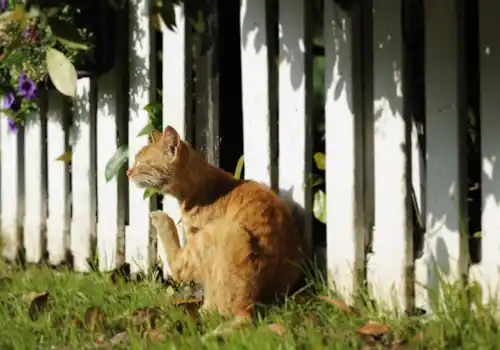Thinking of walking your cat on a lead? We speak to the experts to find out everything you need to know.
The idea of being able to go out with your cat by your side on a lead, just as dog owners do, is very appealing, but it’s important to remember that cats are not dogs.
Nevertheless, many people want to try it in order to give their cats a breath of fresh air, perhaps because they are indoor pets who don’t go out and about on their own.
RSPCA cat welfare expert, Sam Watson understands why people want to do it, but sounds a note of caution for anyone considering it: “It’s something people want to do because they love their cat and want to give them the fullest life possible and lots of opportunities for exploration and enrichment. But I’m a little bit cautious on it. I’d say that very few cats are going to enjoy walking on a leash and for those that do, finding a safe environment for it and training them to be comfortable with it is quite a large undertaking. It requires a lot of thought, preparation, planning, and training. Taking a cat out for a walk on a leash without them experiencing fear or feeling as if they aren’t in control is extremely challenging.
“I think for most cats it’s not a good idea and it’s going to be very high risk for their welfare and sense of well-being, both for their mental and physical health and I’d prefer people put their energies into other activities to enrich their life.
“There are lots of other types of enrichment. You could bring in some different smells from the outdoors. Get a cardboard box and any cat-safe plants and twigs or branches. Give them lots of opportunities to run and jump indoors.”
She also recommends that if you have a garden, setting up a catio — an area outdoors that your cat can use without the risk of escaping and from which they can still get back indoors easily.
Are cats happy on a lead?
Walking a cat on a harness and leash is something that requires a lot of planning and patience to get it right and a lot depends on the individual cat.
Linda Ryan, Cat Advocacy Programme Manager at International Cat Care said: “I’m not a million per cent against it if it’s done properly, but it has to be with the right temperament of cat. If you had a cat that’s naturally anxious or shy or under-confident, it can be disastrous.
“Whereas, if you have a big confident cat and you’ve done all the pre-training, they may enjoy it. It may be something that’s enriching and enjoyable for years, but it may be incredibly stressful, and, in my experience, it is very regularly not done well. There’s a lot of debate about it; there may be pros for some cats with the right preparation and management, but there are a lot of cons,” said Linda, who is a Certificated Clinical Animal Behaviourist and Registered Veterinary Nurse.
Importantly, it’s not just about getting the cat to tolerate and accept the process, they need to actively enjoy it.
“If you plan to walk your cat on a harness it needs to be safe, of course physically, but we need to spend a lot of time building not just acceptance, but confidence and joy with wearing that harness.”
Encouraging a cat to walk with a leash is very different from a dog, says Linda,
“It’s a lot more complex with a cat because remember that these are the ultimate control freaks. Autonomy is the thing that matters. And so even if we’ve trained wearing a harness so that they’re super comfortable before they ever go outside, we’ve trained them to walk on the leash and feel safe and comfortable with that, they are still not going to be autonomously maintaining their own environment. So, if something suddenly scares them, they can only get to the end of the lead, and that’s stressful for a cat. And that’s with the best possible set-up.”
At the other end of the scale, if someone was to just put a harness on a cat with no build-up or preparation that would be far worse. “In my experience there’s going to be enormous distress and anxiety and frustration, and they’re not going to cope with that at all. And it potentially is going to make them feel very, very unsafe outside because the situation itself doesn’t feel safe for them. And then they may encounter a dog or a smell of something that’s unfamiliar or a person that is unfamiliar.
“They are not like dogs in their sociality, being described as ‘selectively social.’ They do not like to go out and meet and greet everybody. They like to go out and quietly do cat stuff by themselves. So, we really need to think about what motivates a cat and why they might find that scenario stressful.”
“And then we also want to think about practical, physical things like what happens if that cat jumps over someone else’s fence, and now you’ve got them on the end of a lead, and they’re over there?”
Animal behaviourist and regular Your Cat contributor, Professor Peter Neville puts this another way. “The thing with cats is that they are 3D and dogs aren’t. Dogs walk along a flat surface, but they don’t climb trees, they don’t jump a wall, they don’t go investigating along little rooves.”
This means that the type of exercise they get being walked is not quite what they need. “The type of exercise that a cat’s getting outside on a harness is really limited compared to what they would do for themselves,” said Peter.
In addition, whereas most dogs are happy to go for a long walk, that’s not what cats do. They like shorter bursts of activity. “They’re not built for long-distance walking like a dog is. Short frequent external excursions for a cat are much better than a two-hour walk.”
He agrees that whether a cat will enjoy being walked on a harness very much depends on the individual cat. “There are some cats who are going to take to it like a duck to water and then there are some cats who for all their lives will never like having a harness put on no matter what you do.
“You can have a cat that is very used to being handled, is very human friendly, you can do what you like to them, and they just love fuss, and you could put a harness on, and they take no notice. You could put a leash onto the harness, and they take no notice, they never pull on the leash because they just want to be with you. Those are the easy ones. Then you’ve got the ones who will never accept it.
“And then you’ve got the ones who you basically go slowly, and you work with them, and you build them up to each stage of what you’re trying to achieve.”
But even if your cat loves going out with the harness on, it’s important to continue to check and take notice of their responses because things can change.
Peter says: “There are some cats who will be happily used to being walked on a leash and harness and then something goes wrong just by accident. A lorry backfires, a dog comes round the corner and then you’ve lost it. And when you lose it with some cats, you’ve lost it for good.”
It’s important to think carefully about your reasons for taking your cat out on a leash as for some cats it may not be giving them the benefits you suppose.
Peter said: “The assumption behind taking a cat out for a walk is that it’s somehow beneficial to them. That being outside is better than being an indoor cat permanently, where nothing really changes. The assumption that a cat is going to enjoy life more by doing this, isn’t necessarily true for every cat.”
While cats with access to the outside world can explore and run and climb around the nearby gardens, many people live in areas where that doesn’t feel safe. “I think people sometimes think I’d like to give the nearest thing I can to that, but I can’t let him run free because of traffic or whatever and so their heart’s in the right place but walking a cat down a street with busy traffic is not something they would ever choose to do. So, place is important. If you could walk a cat around a park or woodland trail, that to me makes more sense than just walking for the sake of it.”
Tips for getting started
While it is possible to train your cat yourself, it is a good idea to do it with the help of an animal behaviourist, especially if you are new to owning cats. “I think that would be one of the kindest ways you could do it, because you’re going to get advice from someone who really has strong expertise in training and should have the ability to help you learn to read your cat’s body language,” says Sam. “It’s extremely important to be able to read the signals that your cat is sending you. They might be subtle, but they will be there.”
If you are doing it yourself, Sam recommends starting when they are young and starting very slowly by showing the cat the harness on the ground and allowing them to sniff it — rewarding them each time they take a step further and perhaps eventually allowing them to put their head into the harness if they want to.
Linda Ryan also recommends making sure the leash is chosen carefully and used carefully. “We want it to be a skinny little lead and used lightly so that there’s no pressure, and we want it to be long so that they’ve got choices.”
If your cat doesn’t like it, don’t push it.
Case study: ‘That time outside makes her happy’
Susie Hewer from East Sussex adopted her cat Shelley from a rescue centre.
“I’d been advised by the rescue centre that due to Shelley’s experiences, she would be best suited to being an indoor cat,” said Susie. “We have a large garden, away from people, and I wondered whether I could take Shelley outside on a lead. I tried it once and it didn’t go well. I then found Supakit’s harnesses and went through the harness training with the Supakit Academy (supakit.co)
“The video tutorials were brilliant and the whole course was about fun and working up to the first outing. I had a trail of cat treats leading to the harness! At first, we practised just walking around the house on the lead before building up to the garden, and I think it was literally just two steps outside before she ran back in. Now, we’re up to about 10 minutes and that is ideal for Shelley, that time outside makes her happy and she has interests both inside the house and outside.”







